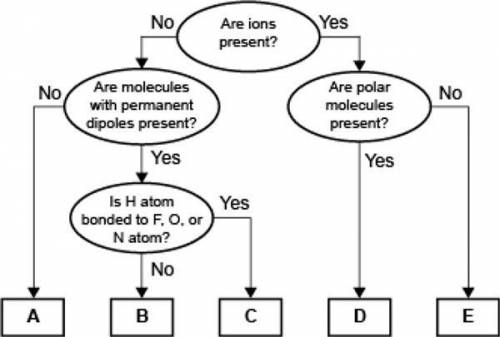
Chemistry, 28.03.2021 22:00 jovellabreu12
A concept map for four types of intermolecular forces and a certain type of bond is shown.
(text explanation of the concept map)(An ellipse is shown. Inside the ellipse is written Are ions present. An arrow from the right side of the ellipse has Yes written on it and points to another ellipse. This ellipse has Are polar molecules present written inside it. This ellipse has two arrows coming out of it. One arrow has Yes written on it and leads to a rectangular box that has D written inside it. The second arrow has No written on it and leads to a rectangular box that has E written inside it. An arrow from the left of the topmost ellipse has No written on it and leads to an ellipse that has Are molecules with permanent dipoles present Written on it. An arrow that has No written on it, points from this ellipse towards a rectangle that has A written inside it. An arrow that has Yes written on it, points from this ellipse towards another ellipse that has Is H atom bonded to F, O, or N atom Written on it. This ellipse also has two arrows coming from it. The arrow with Yes written on it leads to a rectangle that has C written on it and the arrow that has No written on it leads to a rectangle that has B written inside it.)
Compare the relative strength of the two forces B and C. Explain how you determined this comparison by identifying the forces.


Answers: 1
Another question on Chemistry

Chemistry, 22.06.2019 00:30
13. calculate the initial concentration (before precipitation) of carbonate ions after the addition of each 0.05 ml of solution b to the 1.00 l beaker of solution a. divide the work among group members and write the answers in the table in model 3. assume the volume change as solution b is added is negligible. 14. notice the initial concentrations of zn2+ - and cu2+ in the table in model 3. a. explain how these were obtained from the data in model 2. b. as solution b is added and precipitates form, do these initial concentrations change? 15. use the data in model 2 to indicate the presence of precipitate (either znco3 or cuco3) after each 0.05 ml addition of solution b in model 3. 16. use the initial concentrations of carbonate ions and zinc ions to calculate the reaction quotient, qsp for the zinc carbonate scenarios in model 3. divide the work among group members and write the answers in the table in model 3. 17. use the initial concentrations of carbonate ion and copper(ii) ions to calculate the qsp for the copper(ii) carbonate scenarios in model 3. divide the work among group members and write the answers in the table in model 3.
Answers: 3

Chemistry, 22.06.2019 11:30
If blood contains 150g of hemoglobin per liter of blood, how much hemoglobin would be contained in 10 ml of blood
Answers: 2

Chemistry, 23.06.2019 00:30
How can you write e method for the experiment of separating sand from water by filtration process? 1-materials 2-steps 3-conclusion also the same for the separating process of water and salt by filtration or distillation. quick because i need to finish my hw
Answers: 2

Chemistry, 23.06.2019 03:50
Show how to convert the temperature 84.7° c to kelvin. include all steps and label the final answer.
Answers: 1
You know the right answer?
A concept map for four types of intermolecular forces and a certain type of bond is shown.
(text ex...
Questions

Mathematics, 16.05.2021 15:40

Physics, 16.05.2021 15:40

Mathematics, 16.05.2021 15:40

English, 16.05.2021 15:50


History, 16.05.2021 15:50

Social Studies, 16.05.2021 15:50


Physics, 16.05.2021 15:50

Social Studies, 16.05.2021 15:50

Mathematics, 16.05.2021 15:50

Mathematics, 16.05.2021 15:50

Mathematics, 16.05.2021 15:50

Mathematics, 16.05.2021 15:50

English, 16.05.2021 15:50

Mathematics, 16.05.2021 15:50

Arts, 16.05.2021 15:50


English, 16.05.2021 15:50

Mathematics, 16.05.2021 15:50



